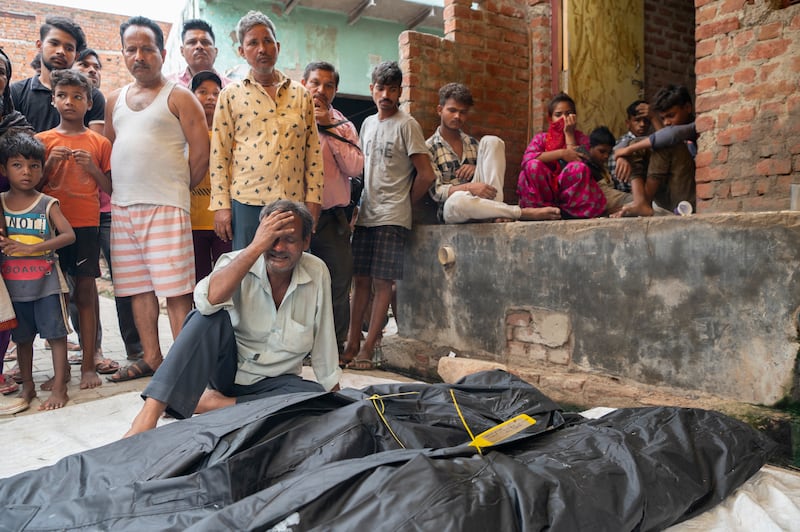The Hindu preacher who organised the “spiritual” gathering of more than 250,000 devotees in north India recently, in which 121 people died in a stampede, is one of numerous self-professed messiahs gainfully operating assorted cults across the country.
The 65-year-old former police constable Suraj Pal Singh, who morphed into a popular “godman” called Bhole Baba or the Innocent Elder in northern Uttar Pradesh state nearly three decades ago, is in hiding. He is wanted for questioning by police following the horrific crush at Hathras, 200km southeast of New Delhi in early July, in which mostly women and children died.
Like other flamboyant “godmen”, Baba professed to being a reincarnation of various Hindu Gods with extraordinary faculties. And, other than using these “talents” to deliver financial and spiritual succour to his indigent and largely low-caste Dalit followers, he also claimed the ability to cure multiple infirmities, physical deformities, blindness and also cancer, albeit in private. In one instance he professed powers to resurrect a 16-year-old dead girl at a crematorium in Agra in Uttar Pradesh in 1998 before police intervened.
Videos posted on Baba’s YouTube channel, with a reported viewership of more than two million, show him arriving at massive jamborees of his disciples, like the one at Hathras, dressed invariably in a resplendent white three-piece suit, in a convoy of 15-20 luxury vehicles, escorted by a phalanx of uniformed outriders astride motorcycles.
READ MORE
An army of volunteers in light pink livery, carrying batons, escort him to an elaborate silver-coloured throne and after the welcoming hysteria of the gathered throng, largely comprising women, has subsided Baba begins his address, promising his adoring laity a utopian existence if they worship him.

Over the years, he has convinced believers that the water drawn up from the ground via handpumps at his home near Hathras, was “Amrit” or nectar that ensures longevity. Baba has also encouraged his devotees to collect the “raj” or “magical dust” kicked up when he walked or drove by, and eyewitnesses said the frenzied scrum to gather this “offering” triggered the fatal stampede at Hathras.
Police, meanwhile, have said Baba faces charges of fraud, land grab and sexual assault. Other godmen – known in India as gurus, yogis, sadhus or swamis – are serving jail sentences for an assortment of crimes.
Police also said many such godmen, with comparable ostentation and glitziness, were unquestioningly idolised by millions across India’s complex and ancient tapestry of religion, spirituality and multiculturalism, with their collective influence transcending all reason and logic among adherents.
Analysts said the godmen’s allure was in direct proportion to their showmanship and theatrical talents and ability to convincingly offer to meet their disciples’ health, financial and spiritual needs in increasingly turbulent times.
Sociologist Badri Narayan said “miracles” performed by godmen have gained popularity in recent times through social media platforms and television channels. Distressed people, he said, flock to them in the belief that they are capable of alleviating hardships and ailments through touch, talismans and libations, in return for obedient veneration.
Political patronage has amplified these godmen’s popularity, with both parties deriving mutual benefit from their dubious associations. Politicians profit from the godmen’s ability to mobilise voters from their considerable congregations and, in turn, provide the latter immunity from criminal prosecution, land grants, tax exemptions and other forms of state sponsorship.
The most recent instance of such interdependence involved 56-year-old Gurmeet Ram Rahim Singh, better known as MSG or Messenger of God, who was sentenced in 2017 to a 20-year jail term for raping two girls and murdering a journalist who exposed his deviancy in the northern Haryana state.
However, Singh’s political connections and cult following of more than 60 million resulted in him being granted parole nine times thereafter – the most recent being in January – invariably before state or parliamentary elections.
As a godman for nearly 30 years, Singh presided over a den of iniquity and perversion at his hermitage through violence, intimidation and blackmail. He was alleged to have ordered the castration of some 400 of his followers to bring them “closer to God” but evaded arrest over years due to political patronage from successive state governments, whom he had helped get elected.














